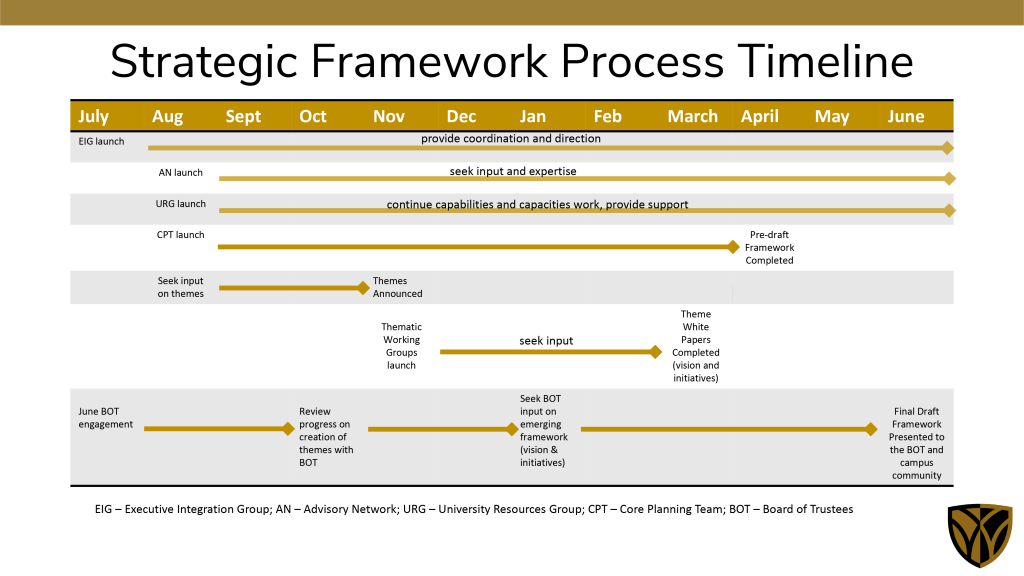Process
The Strategic Framework process was organized in order to do this work in a manner that invited a diversity of perspectives and facilitated inclusivity and collaboration. Accountability and clarity was built into the structure so that the work would progress in a timely manner, there would be transparency throughout the process, and the process would result in a strategic framework that could be wholly embraced by the Wake Forest community.
Structure
The organizational structure is intentional in its layout so as to reflect the clear shared input of the university stakeholders.
Decision Making
The strategic framework will help align strategic resources and initiatives as the university makes future decisions.
We will use a process that is different from any Wake Forest has used in the past. Instead of engaging in strategic planning – which can too easily turn into generating lists of things to do — we will focus on framing a strategy to accomplish our vision and goals together. We must determine the right things to do, and not do, in order to deliver on our mission while navigating complex and challenging times.
President Susan R. Wente
A Living Document
Wake Forest University has a remarkable record of being a great university – providing a transformational educational experience to future leaders. The shared vision described in this strategic framework lays a path for where the University aspires to go and identifies areas of distinctive excellence – both today and in the future. These areas of distinctive excellence are rooted in our purpose, history and commitments. They point us to an aspirational future state in which our impact and reputation are enhanced as a great university serving as a catalyst for good, and where we, as an academic community, have an even greater impact on some of the most compelling issues of the day.
Together, we are building toward Wake Forest’s bicentennial in 2034 and building for a third century of excellence. Framing Our Future is more than a collection of ideas about our present and future. It is a living document that will evolve as these ideas are tested, debated, refined and implemented. It is a tool for aligning critical decisions with our shared vision, unique value proposition Pro Humanitate, thematic goals and strategic aims.
Next steps & updates
The Strategic Framework creates a pathway to alignment as the University prepares for its third century.
Learn more
Feedback & Communication
Constituents within the Wake Forest community were asked to participate in the strategic framework process at key moments in the work. Examples include:
Listening Sessions
A significant number of listening sessions were held to capture the thoughts and ideas of students, faculty, staff, alumni, parents and families, and donors and friends. These sessions, conducted in person and via Zoom, were crucial to understanding the current state of the University as well as key aspirations for the institution.
Poster Sessions
At the conclusion of the Spring 2023 semester, poster sessions were held for the working groups to share their ideas on the future of Wake Forest within each of the five themes and seek feedback from the community.
Surveys
Throughout the year, members of the Wake Forest community were invited to share feedback via the Strategic Framework website.
Generative Discussions
Boards and councils, as well as faculty, staff and student groups, engaged in conversation during the fall and spring semesters. Several groups explored the aspects of Wake Forest that make it unique among the institution’s higher education peers, and those that make it special. Additionally, trustees and volunteer leaders serving on boards and councils took a deep dive into the second thematic goal. In April, trustees also explored the third thematic goal in greater detail.
Communication
Visit this page to see examples of how Wake Forest communicated throughout the framework process.
Initial Timeline
In November 2022, themes were announced based on collective input. The Thematic Working Groups’ work continued through mid-spring, including additional opportunities for community input. In late spring and early summer, the Core Planning Team weaved the thematic work together into the new framework.

Preparing for this process
Wake Forest began setting the stage for this process last year, when President Wente asked the question: “What is expected of a great university today?” The answers to this question — that Great Universities are called to be catalysts for good, and more specifically, to be catalysts for learning and discovery, access and opportunity, and innovation and society – position us to take action this academic year.
Past strategic plans
Across the last four decades, we have been guided by several strategic plans with the most recent conceived between 2007-09. Each moved the University as a whole toward greater distinctiveness.
